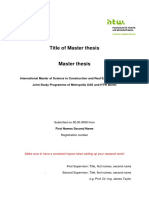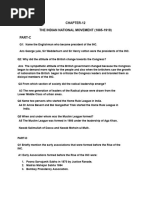Inserting References in L TEX Documents
Inserting References in L TEX Documents
Uploaded by
ncharalaCopyright:
Available Formats
Inserting References in L TEX Documents
Inserting References in L TEX Documents
Uploaded by
ncharalaOriginal Description:
Original Title
Copyright
Available Formats
Share this document
Did you find this document useful?
Is this content inappropriate?
Copyright:
Available Formats
Inserting References in L TEX Documents
Inserting References in L TEX Documents
Uploaded by
ncharalaCopyright:
Available Formats
Inserting References in L
A
T
E
X Documents
IS Skills Development Team
Edition 1, November 2010
Document Reference: 3728-2010
1 Introduction
L
A
T
E
X includes features so you can easily cite references and create bibliogra-
phies in your document. This document will explain how to do this using a
separate BibTeX le to store the details of your references.
2 The BibTeX le
Your BibTeX le contains all the references you want to cite in your docu-
ment. It has the le extension .bib and should be kept in the same folder as
your document .tex le. The .bib le is plain text - it can be edited using
Notepad or your L
A
T
E
X editor (e.g. WinEdt). You should enter each of your
references in the BibTeX le in the following format:
@article{
Birdetal2001,
Author = {Bird, R. B. and Smith, E. A. and Bird, D. W.},
Title = {The hunting handicap: costly signaling in human
foraging strategies},
Journal = {Behavioral Ecology and Sociobiology},
Volume = {50},
Pages = {9-19},
Year = {2001} }
Each reference starts with the reference type (@article in the example
above). Other reference types include @book, @incollection for a chapter in
1
an edited book and @inproceedings for papers presented at conferences
1
.
The reference type declaration is followed by a curly bracket, then the ci-
tation key. Each references citation key must be unique - you can use
anything you want, but a system based on the rst authors name and year
(as in the example above) is probably easiest to keep track of.
The remaining lines contain the reference information in the format
Field name = {field contents},.
You need to include LaTeX commands in your BibTeX le for any special
text formatting - e.g. italics (\emph{Rattus norvegicus}), quotation marks
(...), ampersand (\&).
Surround any letters in a journal article title that need to be capitalised
with curly brackets {...}. BibTeX automatically uncapitalises any capital
letters within the journal article title. For example, Dispersal in the con-
temporary United States will be printed as Dispersal in the contemporary
united states, but Dispersal in the contemporary {U}nited {S}tates will
be printed as Dispersal in the contemporary United States.
You can type the BibTeX le yourself, or you can use reference management
software such as EndNote to create it[3].
3 Citing references
Type \cite{citationkey} where you want to cite a reference in your .tex
document. If you dont want an in text citation, but still want the reference
to appear in the bibliography, use \nocite{citationkey}.
To include a page number in your in-text citation put it in square brackets
before the citation key: \cite[p. 215]{citationkey}.
To cite multiple references include all the citation keys within the curly brack-
ets separated by commas: \cite{citation01,citation02,citation03}.
4 Inserting the bibliography
Type the following where you want the bibliography to appear in your doc-
ument (usually at the end):
1
See the Bibliography Management chapter in the LaTeX Wikibook[1] for a full list of
the reference types that BibTeX knows about, and their required and optional elds.
2
\bibliographystyle{plain}
\bibliography{references}
Where references is the name of your .bib le.
5 Styles
5.1 Numerical citations
L
A
T
E
X comes with several styles with numerical in-text citations, these in-
clude:
Plain The citation is a number in square brackets (e.g. [1]). The bibliog-
raphy is ordered alphabetically by rst author surname. All of the authors
names are written in full.
Abbrv The same as plain except the authors rst names are abbreviated
to an initial.
Unsrt The same as plain except the references in the bibliography appear
in the order that the citations appear in the document.
Alpha The same as plain except the citation is an alphanumeric abbrevi-
ation based on the author(s) surname(s) and year of publication, surrounded
by square brackets (e.g. [Kop10]).
5.2 Author-date citations
Use the natbib package if you want to include author-date citations. Natbib
uses the command \citep{...} for a citation in brackets (e.g. [Koppe,
2010]) and \citet{...} for a citation where only the year is in brackets
(e.g. Koppe [2010]). There are lots of other ways that you can modify
citations when using the natbib package - see the packages reference sheet
for full details[2].
Natbib comes with three bibliography styles: plainnat, abbrvnat and un-
srtnat. These format the bibliography in the same way as the plain, abbrv
3
and unsrt styles, respectively.
5.3 Other bibliography styles
If you want to use a dierent style (e.g. one provided by the journal you
are submitting an article to) you should save the style le (.bst le) in the
same folder as your .tex and .bib les. Include the name of the .bst le in
the \bibliographystyle{...} commmand.
References
[1] L
A
T
E
X Wikibook. http://en.wikibooks.org/wiki/LaTeX, accessed 22
October 2010.
[2] Reference sheet for natbib usage. http://mirror.ctan.org/macros/
latex/contrib/natbib/natnotes.pdf, describing version 8.31a from
2009/11/07.
[3] Skills Development Team. Using EndNote with L
A
T
E
X. https://www.
wiki.ed.ac.uk/x/sZpKBg, accessed 22 October 2010.
4
You might also like
- Transient Stability Analysis of Multi-Machine System88% (8)Transient Stability Analysis of Multi-Machine System38 pages
- Relacion de Las Yslas Filipinas by Miguel de Loarca100% (1)Relacion de Las Yslas Filipinas by Miguel de Loarca25 pages
- Bibliography Management in LaTeX SharelatexNo ratings yetBibliography Management in LaTeX Sharelatex10 pages
- Citing and Referencing in Latex - Using Bibtex: 1. Inserting Citations and Generating A Reference ListNo ratings yetCiting and Referencing in Latex - Using Bibtex: 1. Inserting Citations and Generating A Reference List2 pages
- Indian TEX Users Group: On-Line Tutorial On L TEXNo ratings yetIndian TEX Users Group: On-Line Tutorial On L TEX10 pages
- Creating and Managing Bibliographies With BibTeX On Overleaf - Overleaf, Editor de LaTeX OnlineNo ratings yetCreating and Managing Bibliographies With BibTeX On Overleaf - Overleaf, Editor de LaTeX Online25 pages
- Your Paper's Title Starts Here: Please Center Use Times New Roman 14No ratings yetYour Paper's Title Starts Here: Please Center Use Times New Roman 145 pages
- Keep The Title Short: Firstname LastnameNo ratings yetKeep The Title Short: Firstname Lastname6 pages
- A Bibtex Guide Via Examples: Ki-Joo Kim April 4, 2003No ratings yetA Bibtex Guide Via Examples: Ki-Joo Kim April 4, 20038 pages
- Annotated Biblio Publication Manual of The APA 2019No ratings yetAnnotated Biblio Publication Manual of The APA 20194 pages
- Your Project Title: (EECS 149/249A Class Project)No ratings yetYour Project Title: (EECS 149/249A Class Project)4 pages
- LaTeX - Bibliography Management - Wikibooks, Open Books For An Open WorldNo ratings yetLaTeX - Bibliography Management - Wikibooks, Open Books For An Open World22 pages
- Bibtex Entry Types, Field Types and Usage HintsNo ratings yetBibtex Entry Types, Field Types and Usage Hints9 pages
- DCC383A72F77287087119E461A1CEA49280EA6E8No ratings yetDCC383A72F77287087119E461A1CEA49280EA6E89 pages
- Alternate Acm Sig Proceedings Paper in Latex Format: (Extended Abstract)No ratings yetAlternate Acm Sig Proceedings Paper in Latex Format: (Extended Abstract)5 pages
- A Sample Technical Paper in Latex FormatNo ratings yetA Sample Technical Paper in Latex Format3 pages
- Title of Paper: Surname INITIALS, Surname INITIALS and Surname INITIALSNo ratings yetTitle of Paper: Surname INITIALS, Surname INITIALS and Surname INITIALS10 pages
- The Newest - Manuscript Template-NOTION-2023No ratings yetThe Newest - Manuscript Template-NOTION-20237 pages
- EXTENDED ABSTRACT - PAPER TITLE (Use Style: Paper Title)No ratings yetEXTENDED ABSTRACT - PAPER TITLE (Use Style: Paper Title)2 pages
- APA Style Guidelines & Examples (6th Edition) NAIT Library: Rev. April 2014, ADNo ratings yetAPA Style Guidelines & Examples (6th Edition) NAIT Library: Rev. April 2014, AD40 pages
- Sources and Sinks Vortex Doublet Rankine PDFNo ratings yetSources and Sinks Vortex Doublet Rankine PDF21 pages
- MEPC 60-13 - The Generation of Biocide Leaching Rate Estimates For Anti-Fouling Coatings and Their Use... (IPPIC)No ratings yetMEPC 60-13 - The Generation of Biocide Leaching Rate Estimates For Anti-Fouling Coatings and Their Use... (IPPIC)18 pages
- Safety and Health in Shipbuilding and Ship RepairNo ratings yetSafety and Health in Shipbuilding and Ship Repair267 pages
- Legion Quick Reference Sheet: Access. Job Script Options. Resource LimitsNo ratings yetLegion Quick Reference Sheet: Access. Job Script Options. Resource Limits1 page
- Chapter 17: Waves II: Sound Waves Are One Example of Longitudinal WavesNo ratings yetChapter 17: Waves II: Sound Waves Are One Example of Longitudinal Waves30 pages
- Matlab Basics: Yaara Erez MRC Cognition and Brain Sciences Unit November 2013No ratings yetMatlab Basics: Yaara Erez MRC Cognition and Brain Sciences Unit November 201322 pages
- Ernest Kaiser Racial Dialectics - The Aptheker-Myrdal ControversyNo ratings yetErnest Kaiser Racial Dialectics - The Aptheker-Myrdal Controversy9 pages
- Caterpillar Lift Truck Npp20m Operation Maintenance ManualNo ratings yetCaterpillar Lift Truck Npp20m Operation Maintenance Manual22 pages
- Calculation Sheet (Man-Hours, Consumable and Materials)No ratings yetCalculation Sheet (Man-Hours, Consumable and Materials)248 pages
- What Is Art?: Definition of Arts According To Well-Known Philosophers and ArtistsNo ratings yetWhat Is Art?: Definition of Arts According To Well-Known Philosophers and Artists9 pages
- Report From The Department of Justice June 3, 2016 Catharine E. ReevesNo ratings yetReport From The Department of Justice June 3, 2016 Catharine E. Reeves28 pages
- Planning and Recruiting Human ResourcesNo ratings yetPlanning and Recruiting Human Resources33 pages
- CH-12, THE INDIAN NATIONAL MOVEMENT (1885-1919)No ratings yetCH-12, THE INDIAN NATIONAL MOVEMENT (1885-1919)5 pages
- Training Programme For Commercial AssistantsNo ratings yetTraining Programme For Commercial Assistants6 pages
- Transient Stability Analysis of Multi-Machine SystemTransient Stability Analysis of Multi-Machine System
- Relacion de Las Yslas Filipinas by Miguel de LoarcaRelacion de Las Yslas Filipinas by Miguel de Loarca
- Citing and Referencing in Latex - Using Bibtex: 1. Inserting Citations and Generating A Reference ListCiting and Referencing in Latex - Using Bibtex: 1. Inserting Citations and Generating A Reference List
- Creating and Managing Bibliographies With BibTeX On Overleaf - Overleaf, Editor de LaTeX OnlineCreating and Managing Bibliographies With BibTeX On Overleaf - Overleaf, Editor de LaTeX Online
- Your Paper's Title Starts Here: Please Center Use Times New Roman 14Your Paper's Title Starts Here: Please Center Use Times New Roman 14
- A Bibtex Guide Via Examples: Ki-Joo Kim April 4, 2003A Bibtex Guide Via Examples: Ki-Joo Kim April 4, 2003
- Annotated Biblio Publication Manual of The APA 2019Annotated Biblio Publication Manual of The APA 2019
- LaTeX - Bibliography Management - Wikibooks, Open Books For An Open WorldLaTeX - Bibliography Management - Wikibooks, Open Books For An Open World
- Alternate Acm Sig Proceedings Paper in Latex Format: (Extended Abstract)Alternate Acm Sig Proceedings Paper in Latex Format: (Extended Abstract)
- Title of Paper: Surname INITIALS, Surname INITIALS and Surname INITIALSTitle of Paper: Surname INITIALS, Surname INITIALS and Surname INITIALS
- EXTENDED ABSTRACT - PAPER TITLE (Use Style: Paper Title)EXTENDED ABSTRACT - PAPER TITLE (Use Style: Paper Title)
- APA Style Guidelines & Examples (6th Edition) NAIT Library: Rev. April 2014, ADAPA Style Guidelines & Examples (6th Edition) NAIT Library: Rev. April 2014, AD
- Formatting for File Conversion and PublicationFrom EverandFormatting for File Conversion and Publication
- MEPC 60-13 - The Generation of Biocide Leaching Rate Estimates For Anti-Fouling Coatings and Their Use... (IPPIC)MEPC 60-13 - The Generation of Biocide Leaching Rate Estimates For Anti-Fouling Coatings and Their Use... (IPPIC)
- Legion Quick Reference Sheet: Access. Job Script Options. Resource LimitsLegion Quick Reference Sheet: Access. Job Script Options. Resource Limits
- Chapter 17: Waves II: Sound Waves Are One Example of Longitudinal WavesChapter 17: Waves II: Sound Waves Are One Example of Longitudinal Waves
- Matlab Basics: Yaara Erez MRC Cognition and Brain Sciences Unit November 2013Matlab Basics: Yaara Erez MRC Cognition and Brain Sciences Unit November 2013
- Ernest Kaiser Racial Dialectics - The Aptheker-Myrdal ControversyErnest Kaiser Racial Dialectics - The Aptheker-Myrdal Controversy
- Caterpillar Lift Truck Npp20m Operation Maintenance ManualCaterpillar Lift Truck Npp20m Operation Maintenance Manual
- Calculation Sheet (Man-Hours, Consumable and Materials)Calculation Sheet (Man-Hours, Consumable and Materials)
- What Is Art?: Definition of Arts According To Well-Known Philosophers and ArtistsWhat Is Art?: Definition of Arts According To Well-Known Philosophers and Artists
- Report From The Department of Justice June 3, 2016 Catharine E. ReevesReport From The Department of Justice June 3, 2016 Catharine E. Reeves





































































































